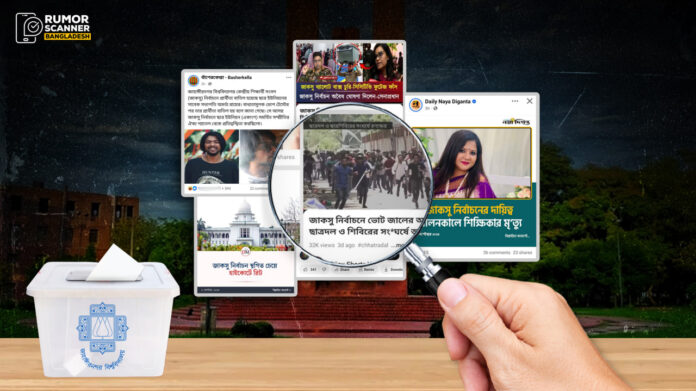After 33 long years, the Jahangirnagar University Central Students’ Union (JUCSU) election was held on September 11. Out of 25 posts, candidates from the Bangladesh Islami Chhatra Shibir-backed “Somonnito Shikkharthi Jote” panel won 20 posts, including General Secretary (GS) and two Assistant General Secretary (AGS) positions. However, the Vice President (VP) post was won by a candidate from the “Swatantra Shikkharthi Sammilon” panel. The election saw extensive campaigning, both in favor and against candidates, on social media. The spread of false information to discredit rival panels or candidates was also noticeable. To identify such misinformation, the Rumor Scanner Team monitored election-related online content from the start. As a result, 14 rumors related to the election were identified on the internet. Of these, 10 (71.43%) were classified as false, and 4 (28.57%) were deemed misleading.
During the campaign period, on September 7, Rumor Scanner identified the first piece of misinformation regarding the JUCSU election. On that day, some Facebook posts claimed that Amartya Roy, the former president of the Jahangirnagar University branch of the Students’ Union (a faction) and the Vice President (VP) candidate of the left-leaning “Sampriti Oikko” panel, had his candidacy canceled following a dope test. However, Rumor Scanner found no truth to this claim. It was revealed that Amartya Roy’s candidacy was not canceled due to a dope test but rather because he did not hold regular student status, as per the JUCSU constitution.
The following day, on September 8, another rumor involving Amartya Roy surfaced. Unlike the previous rumor, this one did not originate from social media but spread to social media from mainstream media. At least 40 media outlets published reports claiming that Amartya Roy, the VP candidate of the “Sampriti Oikko” panel, had filed a writ in the High Court to suspend the JUCSU election. However, further investigation revealed different facts. It was found that Amartya Roy had not filed a writ to suspend the JUCSU election but rather to reinstate his canceled candidacy.
The highest number of rumors on election day
On September 11, the JUCSU election polling was held. Voting took place from 9:00 AM to 5:00 PM. Due to voter turnout, polling at two centers continued until 7:00 PM. On this day, citing allegations of irregularities and bias, five panels, including the Bangladesh Jatiotabadi Chatradal backed panel, announced a boycott of the election before and after the polling period. In addition to candidate related complaints, accusations of widespread irregularities, disorder, and partisan influence led three university teachers, Professor Nazrul Islam, Professor Shamima Sultana, and Professor Nahrin Islam Khan, to withdraw from their election duties. On this day, Rumor Scanner identified the highest number of rumors (six) surrounding the election.
During the afternoon, while voting was ongoing, shortly after the Chatradal panel’s boycott announcement, a video circulated on social media claiming it depicted Shibir’s actions against Chatradal. The video showed a large number of people holding sticks. Rumor Scanner verified that the video was not from September 11, and no such incident occurred at Jahangirnagar University that day. In fact, it was footage from July 16, 2024, when quota reform protesters gathered at JU. This was a video recorded during that event.
During polling, a video spread on social media claiming it showed vote rigging in the JUCSU election. The video depicted two young men illegally stuffing a large number of ballot papers into a ballot box. Investigation revealed that the video was not from the JUCSU election and has been circulating online since 2015.
Additionally, in the afternoon, a video of police action circulated on social media with a caption claiming, “Dire situation at Jahangirnagar University, police sided with Shibir. Fears of numerous casualties.” However, verification confirmed the claim was false. The video was from July 17, 2024, showing a clash between police and quota reform protesters.
On the same day, two videos circulated on social media claiming clashes between Chatradal and Shibir at JU. However, investigation found no evidence of such clashes that day. One video was from a February 2025 incident at Dhaka University’s Madhur Canteen, where a clash occurred during the announcement of partial committees for the central and Dhaka University branches of Bangladesh Ganatantrik Chhatra Sangsad. This video was falsely presented as a clash between Chatradal and Shibir at JU. Additionally, another video with the same claim was from a 2023 clash between Awami League and BNP in Patuakhali.
A YouTube video claimed that CCTV footage of Shibir’s vote theft in the JUCSU election had been leaked and that Army Chief General Waker-Uz-Zaman had declared the election invalid. Verification showed that no credible evidence supported these claims. The footage in the video was taken from media reports about Chatradal’s boycott and certain teachers’ withdrawal from election duties, with no connection to the claims made.
The Scope of Rumors Expands Due to Delayed Election Results Announcement
Although the JUCSU election commission claimed that vote counting, which began on the night of September 11, would be completed by noon on September 12, the commission could not finish counting even by the night of September 12. This led to widespread discussion and criticism on social media. On the morning of September 12, Jannatul Ferdous Moumita, an assistant professor in the Fine Arts Department who served as the polling officer for Pritilata Hall in the JUCSU election, suddenly fell ill while participating in vote counting.
She was taken to the hospital, where doctors declared her dead. In connection with her death, at least 20 media outlets published reports featuring a photo of a different woman named Jannatul Ferdous Ananya. That woman, who works for a private television channel, confirmed her identity herself.
On this day, the Rumor Scanner Team identified three pieces of false information related to allegations of election irregularities. A video of a torchlight procession by Chatradal at Dhaka University in July, demanding justice for the murder of a BNP leader in Cox’s Bazar, was circulated, falsely claiming it was a protest against Shibir’s vote theft in the JUCSU election. Additionally, a video of a 2022 clash between Chhatra League and Chatradal at Dhaka University and footage from a recent media report of a clash between Chatradal and Shibir in Barisal were used to claim a Chatradal-Shibir clash at JU. Furthermore, another video, claiming a face-off between Shibir and Chatradal and a police operation on campus, was circulated; this was actually footage from a police action during the quota reform movement in July 2024.
On the same day, a photocard designed in the style of Kaler Kantho, quoting Bangladesh Islami Chhatrashibir’s central president Jahidul Islam, was circulated. It claimed that the Shibir president said, “If Shibir is not declared the winner in JUCSU, Jahangirnagar University will be flooded with blood.” In reality, the Shibir president made no such statement, and Kaler Kantho did not publish any such photocard.
Approximately 48 hours after polling, the election results were announced on the afternoon of September 13. The election commission claimed that due to demands from multiple panels, votes were counted manually instead of using the OMR method with machines, which caused the delay in announcing the results.
The day after the results were announced, on September 14, a photo of Sohagi Samia, the AGS (female) candidate from the “Sangshaptak Parishad” panel supported by another leftist faction and an organizer of the Socialist Students’ Front university branch, was circulated in an injured state. It was claimed that Chhatrashibir attacked leftists on campus after winning the election. However, verification revealed that the photo was from the quota reform movement in 2024. In reality, no such attack by Shibir on leftists occurred on campus after the JUCSU election.
Which Panel Was Targeted by the Most Rumors?
In the JUCSU election, the highest number of rumors, nine, were spread involving the Bangladesh Islami Chhatrashibir backed “Somonnito Shikkharthi Jote” panel. Approximately 89 percent of these rumors were against the panel’s image. The next in line was the Bangladesh Bangladesh Jatiotabadi Chatradal backed panel, which was linked to five rumors, with 80 percent of them creating a negative perception of the panel. Outside of these two panels, two rumors, both negative, were spread involving the “Sampriti Oikko” panel, supported by a section of leftists.
Rumors Involving Candidates
Among the JUCSU election candidates, two pieces of false information were spread involving Amartya Roy, the VP candidate of the “Sampriti Oikko” panel. Notably, two days before polling, a final court decision canceled Amartya Roy’s candidacy, preventing him from participating in the election. Apart from Amartya, rumors were also spread about two other candidates. Rumor Scanner identified one rumor, in favor, involving Mazharul Islam, the GS candidate of the “Somonnito Shikkharthi Jote” panel, and one rumor, in favor, involving Sohagi Samia, the AGS female candidate of the “Sangshaptak Parishad” panel.
Rumors by Candidate Gender
Regarding the JUCSU election, rumors were spread on the internet involving two male candidates and one female candidate. Of these, three rumors involved male candidates, and one involved a female candidate.
Rumors Involving Other Individuals
Evidence was found of one false statement, negative, spread in the name of Bangladesh Islami Chhatrashibir’s president, Jahidul Islam. Additionally, one piece of misinformation, negative, was spread through media and social media involving Jannatul Ferdous Ananya, a journalist at Independent Television.
Rumors Involving Security Forces
State forces were not spared from rumors either. Evidence was found of two rumors involving the Bangladesh Police. Additionally, one rumor was spread involving the Bangladesh Army, specifically mentioning its chief, General Waker-Uz-Zaman
Misinformation by Media
Not only social media but also mainstream media contributed to the rumors. In two separate incidents related to the JUCSU election, at least 62 media outlets published false information. Among them, six media outlets jointly topped the list by spreading two pieces of false information each. The remaining 56 media outlets each spread one piece of false information.
Misinformation was also targeted at media outlets. Evidence was found of one fake photocard circulated in the name of the national daily Kaler Kantho.
Types of Rumors
Among the total identified misinformation, video based misinformation was the most prevalent, with nine instances, approximately 64 percent. Additionally, there were three text based misinformation instances, approximately 21 percent, and two image based misinformation instances, approximately 14 percent.
Youth as the Target of Rumors
An age based analysis of misinformation spread during the JUCSU election showed that five individuals aged 18 to 35 were linked to false information. Additionally, one middle aged individual aged 36 to 59 was involved in misinformation. However, no evidence was found of rumors involving children or elderly individuals.
Facebook as the Main Source of Rumors, Instagram Not Far Behind
Among social media platforms, Facebook had the highest number of rumors, with 13 instances, accounting for approximately 93 percent of the total rumors. The next in line was Instagram, another Meta platform, with nine rumors, approximately 64 percent. Additionally, evidence was found of five rumors on YouTube, three on TikTok, three on Threads, and one on X. However, since some rumors were spread across multiple platforms, the platform based rumor count (13 + 9 + 5 + 3 + 3 + 1 = 34) appears higher than the total number of rumors (14).
Methodology
This study was prepared based on reports published on Rumor Scanner’s website regarding the JUCSU election. For this, we collected and analyzed data from all fact check reports related to JUCSU published between September 7 and September 14. To make it easier for readers to understand, this information was divided into various sections and presented through graphs, charts, and analytical writing.






